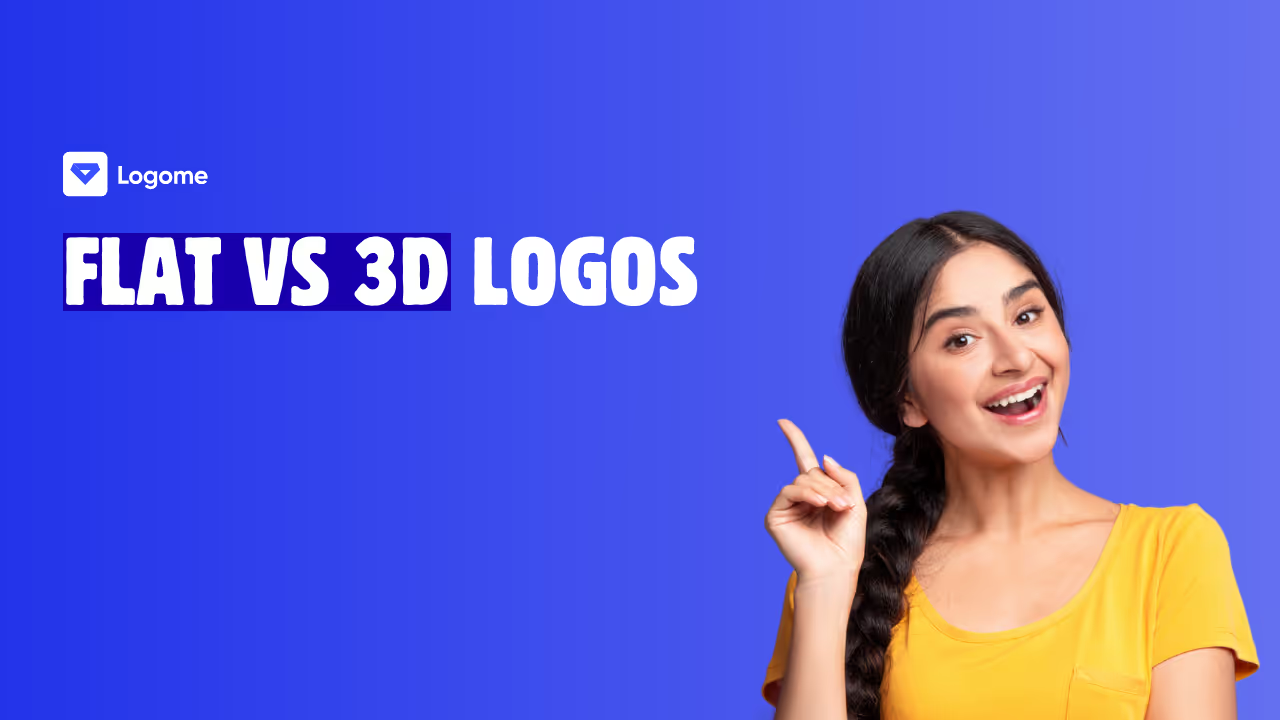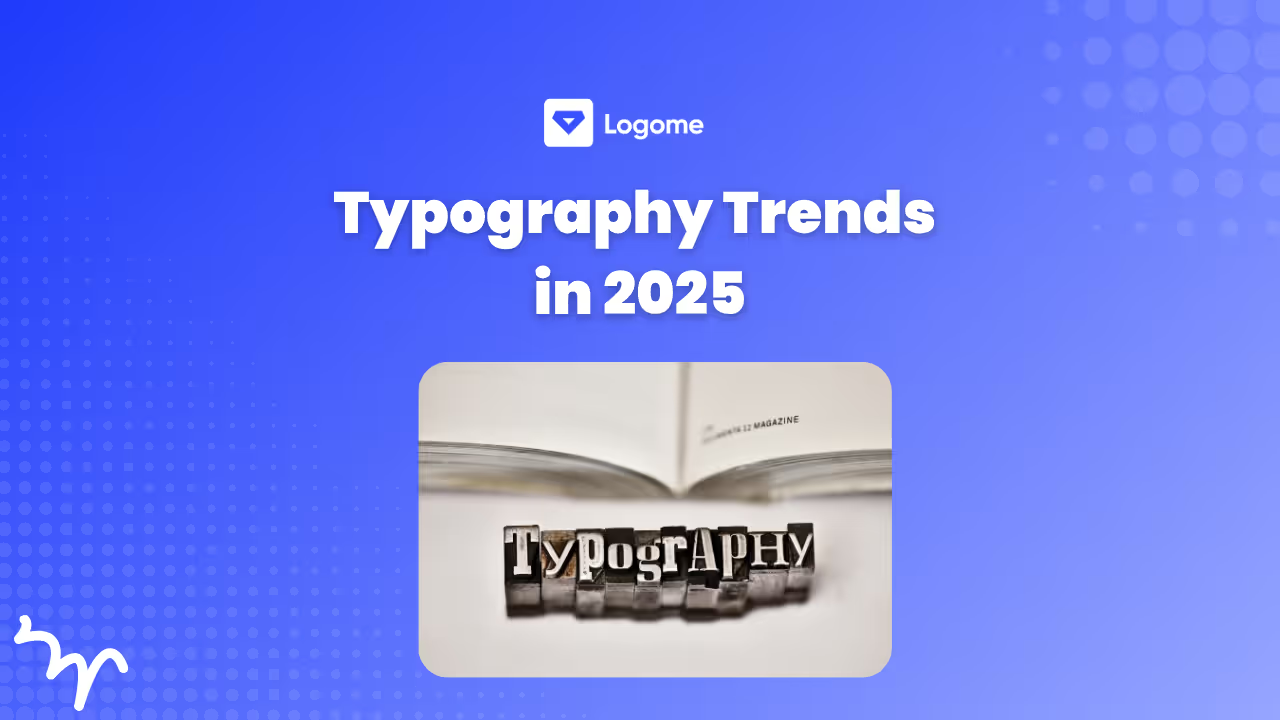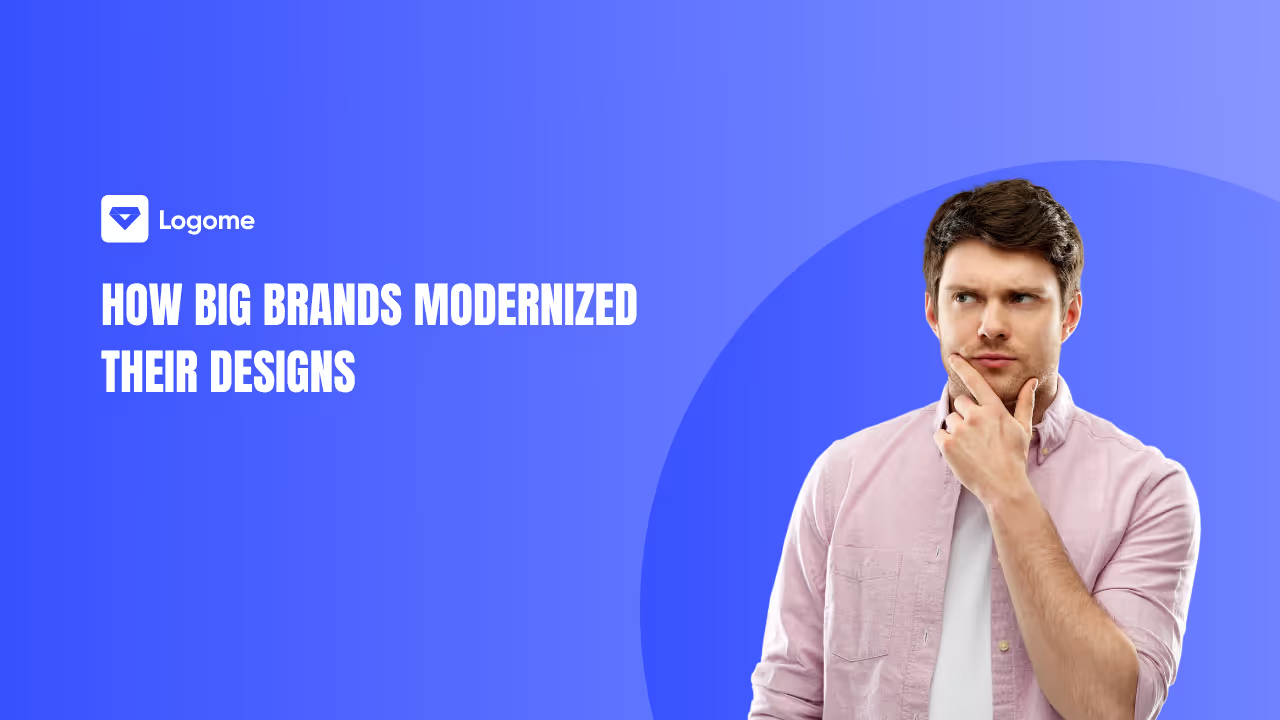Flat vs 3D Logos: Which Trend Dominates 2025?
Explore flat logo design and 3D logo trends for 2025. Learn how to choose, test, and apply the right logo style across channels for your brand’s identity.
Explore flat logo design and 3D logo trends for 2025. Learn how to choose, test, and apply the right logo style across channels for your brand’s identity.

A logo isn’t just a design; it’s a brand’s first impression. And in the fast-changing world of design, two styles are battling for the spotlight — the clean simplicity of flat logo design and the eye-catching realism of 3D. Open any major rebrand today, and you’ll see the contrast: some brands are stripping everything back, while others are adding depth, movement, and texture to stand out.
But which one truly leads 2025? The answer isn’t as straightforward as picking sides. The best logos today don’t follow trends blindly; they adapt to where they’ll live — on screens, in motion, or inside virtual spaces. In this article, we’ll explore how flat and 3D logos are evolving, what’s influencing the shift, and how to decide which approach fits your brand’s identity and audience best.
Design terms evolve fast. What we called flat or 3D a decade ago doesn’t look the same today. Before comparing their impact, it’s worth redefining what these two styles truly represent in 2025 — because both have matured far beyond the clichés and now serve very different purposes in branding and design.
Flat logos today aren’t just plain shapes or solid colors. They’ve evolved into adaptive systems that fit seamlessly across devices, backgrounds, and platforms. A 2025 flat design may include gradients or soft shadows, but with restraint and purpose, keeping simplicity at its core.
This style is built for flexibility. It scales cleanly on app icons, web headers, and even smartwatch screens. Its simplicity ensures faster loading, sharper legibility, and consistent recognition everywhere — from social feeds to storefronts.
The aim isn’t to look trendy but to communicate clearly. Brands like Google, Spotify, and Airbnb use this modern flat style to stay approachable while maintaining an instantly recognizable identity. It’s about being functional, timeless, and easy to adapt to any medium.
3D logos have evolved from the glossy, overdone styles of the 2000s into sophisticated, tactile visuals. They now use refined lighting, texture, and realistic depth to feel natural rather than loud. This modern 3D approach creates a sense of movement, realism, and storytelling that static visuals can’t match.
Industries that thrive on emotion and innovation — gaming, fashion, tech, and entertainment — are driving this revival. Animated 3D logos, rotating icons, or subtle depth effects give brands an engaging, human touch that feels alive on digital screens.
As augmented and virtual reality become mainstream, 3D branding is finding its place in immersive marketing. A dimensional logo stands out beautifully in AR, motion ads, and product experiences, giving brands presence in both physical and virtual spaces.
Think of flat logos as the foundation — clean, consistent, and reliable. They are the backbone of modern identity systems. 3D logos, on the other hand, bring a brand’s energy to life. They’re expressive storytellers that connect emotionally through texture, light, and motion.
Instead of seeing them as competitors, consider them partners. The most forward-thinking brands use flat and 3D interchangeably — flat for utility and clarity, and 3D for storytelling and impact.
When choosing between flat and 3D logos, the real question isn’t which style looks better — it’s where your logo will live. A design that feels stunning on a billboard might lose its impact as a tiny app icon. Understanding how each style performs across different touchpoints helps you make a smarter, more strategic choice.
In mobile apps, websites, or smartwatch displays, clarity always wins. Flat logos shine in these spaces because they remain crisp even at tiny sizes. They load faster, adapt to different themes, and don’t lose definition on high-resolution screens.
3D logos, while visually appealing, often struggle here. Small details like lighting or shadows get lost, making the design appear blurry or inconsistent. That’s why most app icons and interface logos stick with flat or slightly layered variants — they’re practical and easy to scale.
When it comes to print, embroidery, or packaging, flat logos dominate. They’re easier to reproduce across materials — whether printed on fabric, engraved on metal, or pressed onto packaging. The simplicity ensures consistency no matter the medium.
3D logos, however, can still play a role in physical experiences. With advanced printing and embossing techniques, brands can add depth and texture to packaging or store signage, giving customers a tactile connection without overcomplicating the design.
In campaigns or big brand unveilings, 3D logos steal the spotlight. Their dimensionality makes them perfect for motion graphics, video intros, and immersive brand reveals. They help brands appear modern, innovative, and dynamic.
For brands that rely heavily on storytelling — like gaming studios, luxury fashion houses, or tech startups — a 3D logo can create emotional resonance. It captures attention instantly and delivers that cinematic “wow” factor flat logos can’t match.
On fast-moving platforms like Instagram, TikTok, and YouTube, versatility is everything. Flat logos maintain sharpness in static posts, while 3D variants perform well in motion-based ads or reels. The combination of both can keep your brand visually dynamic and consistent across formats.
For example, using a flat logo as a profile image keeps your brand recognizable, while using a 3D animated logo in videos adds storytelling power. This balance keeps your identity consistent without feeling repetitive.
The design landscape in 2025 is shaped by a blend of restraint and expression. Brands are realizing that audiences crave both clarity and character — minimalism still builds trust, but depth and texture spark emotion. Let’s look at what market data and creative trends reveal about how flat and 3D logos are evolving this year.
Most design trend reports point toward a balance between simplicity and expressiveness. Flat design continues to dominate digital environments because it supports speed, accessibility, and responsiveness. But reports from agencies and design platforms also highlight the rising influence of dimensionality — subtle gradients, shadows, and motion layers that add realism without clutter.
This hybrid evolution is reshaping how brands think about their identities. Instead of replacing flat logos with 3D ones, companies are extending their logo systems. The flat mark acts as the core identity, while its dimensional or animated variants bring campaigns and digital experiences to life.
The 3d logo trend 2025 is being driven by two forces — technology and experience. With the rapid rise of AR, VR, and immersive e-commerce, dimensional design is no longer just aesthetic; it’s functional. 3D logos feel more “real” in digital spaces, helping brands appear tangible in virtual stores, games, and product demos.
Social media platforms are also fueling this movement. Consumers are drawn to logos that pop — designs with motion, texture, or light instantly grab attention in crowded feeds. This is why many brands now introduce 3D versions for video intros, interactive ads, or even NFTs, while keeping their main mark flat and simple.
The biggest indicator of this shift comes from major brand refreshes. Companies like Pepsi, Burger King, and Intel have leaned into flatter aesthetics — proof that minimalism isn’t going anywhere. At the same time, newer tech and fashion brands are experimenting with soft 3D gradients, motion transitions, and fluid animations to feel current and dynamic.
These dual directions show how flexible branding has become. Flat remains the backbone — clean, scalable, and timeless. 3D builds emotion and depth — perfect for storytelling and visual engagement. The result isn’t a tug of war between two trends but a harmony between clarity and creativity.
Trends are inspiring, but data drives smart design choices. Instead of guessing which logo style fits your brand, you can test it. This five-step framework helps you evaluate how your logo performs across usability, performance, and accessibility — real-world factors that separate what looks good from what works.
Show your logo to five people for five seconds, then ask what they remember. If they can’t describe its shape or colors, it’s too complex. Flat designs usually win this test because of their simplicity, but a refined 3D mark with strong contrast can also pass if its form is distinctive.
Shrink your logo to the size of a browser tab icon. Does it stay recognizable, or does it blur into pixels? Most 3D details disappear at small scales, making flat or semi-flat marks more effective. If your 3D version fails, simplify its geometry or create a secondary flat version for small surfaces.
Good design must be inclusive. Run your logo through a contrast checker to ensure it meets accessibility guidelines. Avoid heavy shadows or subtle gradients that reduce clarity for users with low vision. A flat logo with clear edges and balanced color contrast always performs better in accessibility audits.
If your logo includes animation, test how it behaves when motion is turned off. Many users prefer reduced-motion experiences due to accessibility settings or slower devices. Provide static fallback versions so your logo still feels complete without animation. This step keeps your brand inclusive without sacrificing visual flair.
Performance affects perception. A logo that delays page loading hurts user experience and SEO. Measure its impact on Largest Contentful Paint (LCP). Use lightweight file formats — SVG for flat assets, WebP or Lottie for motion, and compressed GLB for 3D. Defer loading for animations so they don’t block content.
If you want to compare variations fast, prototype both flat and 3D versions in Logome. Generate options, run them through these five tests, and gather quick feedback from teammates or clients. You’ll quickly see which version performs better in context before spending on full production.
Designing a logo is only half the job — managing it across platforms is where many brands struggle. Without clear structure, even the best design can lose quality, consistency, and accessibility. This section breaks down how to prepare, organize, and maintain both flat and 3D logos so your brand always looks professional and cohesive.
Flat logos should be created in vector format, usually SVG or AI files. These ensure scalability and sharpness on every screen or print material. Always include multiple variations — full-color, monochrome, and inverted — to cover light and dark backgrounds. Add small-size lockups to keep detail intact when the logo appears tiny, like in app icons or email headers.
To maintain brand consistency, establish grid spacing, clear margins, and proportion rules. Document these in a simple brand guide so developers, marketers, and designers all work from the same reference. The fewer interpretations your logo has, the stronger your visual identity becomes.
For 3D designs, organization is everything. Work with Blender, Cinema 4D, or Maya to create high-resolution master files. From there, export still images in WebP or PNG for static use, and animations in MP4 or Lottie for motion graphics. For interactive environments or AR, use optimized GLB or USDZ formats.
Keep the file sizes reasonable — heavy animations slow load times and frustrate users. As a rule, campaign videos should stay under two megabytes when possible, with short looping animations limited to five seconds. Quality is important, but performance builds trust.
Once your logo assets are ready, communicate how they should be used. Provide alt text descriptions for accessibility, safe-area padding for responsive design, and fallback images for motion-disabled settings. Include guidance on loading order, ensuring heavier assets like 3D animations don’t delay the main page render.
Developers should know where each version belongs: SVG for interfaces, WebP for visuals, and GLB for AR experiences. Meanwhile, marketing teams need clear instructions on color accuracy and file export standards to avoid mismatched hues across print and digital.
Centralize your assets in one source of truth — a shared brand library or digital asset manager. Use simple, descriptive naming like “logo_primary_flat.svg” or “logo_campaign_3d_v2.mp4.” Add version numbers and update logs so no one uses outdated visuals. Include usage notes for each file, explaining where and when it should be applied.
Good governance doesn’t just save time; it protects your brand. When every designer, agency, and partner works from the same structured system, your logo maintains its integrity everywhere it appears — from a website favicon to an AR product launch.
The flat vs 3D logo debate isn’t about winners and losers — it’s about balance. Flat logos give you clarity, speed, and versatility across every screen. 3D adds depth, energy, and emotional pull when you want to make an impression.
The smartest brands now use both. Keep your flat logo as the everyday identity and bring out your 3D version for storytelling, motion, and campaigns. Test both through Logome before deciding — the goal isn’t to follow a trend but to build a system that adapts and lasts.
Flat logo design is a two-dimensional style that uses clean shapes, simple lines, and minimal detail to ensure clarity and scalability across all media. It avoids heavy shadows or textures, keeping the design modern and easy to recognize.
Brands use flat logos because they load quickly, look sharp on any screen size, and maintain readability in digital and print formats. The simplicity also helps strengthen brand recall and makes the design more adaptable across different platforms.
Start by defining your brand’s personality, sketch simple geometric shapes, and refine the design using vector tools like Illustrator or Figma. Keep the typography minimal, use limited colors, and test visibility across light and dark backgrounds.
Flat logos are minimal and optimized for digital use, while 3D logos use lighting, texture, and motion to create realism and emotional depth. Flat designs suit everyday branding, whereas 3D shines in storytelling, motion, and immersive experiences.
Absolutely. Flat design remains the foundation of modern branding because of its versatility and clarity. Many brands now blend flat and 3D styles, keeping flat as their core identity while using 3D for expressive campaigns and digital activations.



Discover how 500,000+ businesses and creators are using our AI logo maker in their Logo creation.



